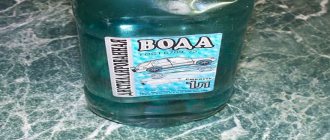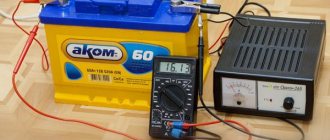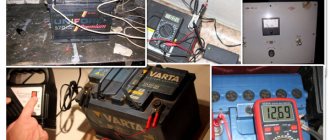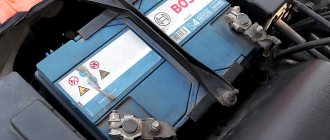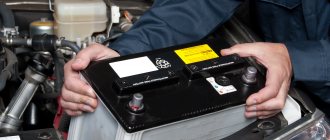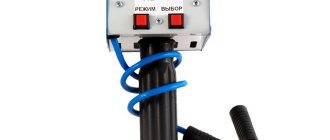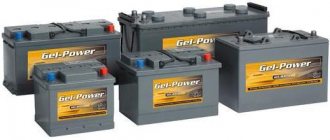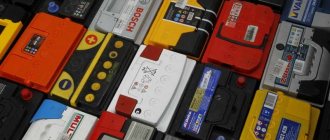Nothing lasts forever, especially when it comes to a car and its components. There comes a time when the battery exhausts its service life. When this happens, the car owner heads to the store to purchase a new power source.
The battery life, as a rule, does not exceed 3-5 years. Probably not as much as we would like. But there is nowhere to go, because without it the car will not start. It also performs other functions, but starting the engine is the main task of the battery.
Dry-charged battery: what is it, why are they produced and how much do they cost?
This type of battery got its name due to the absence of electrolyte in the banks at the time of completion. The production of dry-charged batteries assumes that the lead plates are charged and the product itself is hermetically sealed in a factory environment. The price of such a power source is from 1500 rubles.
What to put in a dry battery? Since a dry-charged battery is a regular lead-acid battery, it must be filled with electrolyte. The latter can either be purchased ready-made in a store or prepared independently from acid and distilled water.
Dry-charged batteries are produced so that the owner has the opportunity to store the battery for a long time before its first use, for example, during storage. Due to the low rate of chemical processes, batteries without electrolyte are practically not subject to self-discharge. This allows you to store it for an incredibly long time.
What to fill
We have already figured out that these specific devices for cars, convenient in many respects, cannot be used immediately due to the lack of liquid filler in them. What can and should be poured into a dry-charged battery to bring it into working condition?
As mentioned above, this type of battery, from the point of view of design and principle of operation, is no different from the lead-acid batteries that are familiar to everyone. Therefore, it must be filled with electrolyte in the same way.
The ready-made electrolyte solution is sold in retail chains. It is important to determine the required volume, which depends on the capacity of the battery: the higher it is, the more fluid is required.
You can also prepare the solution yourself, even at home, with concentrated sulfuric acid and distilled water available. An electrolyte is nothing more than an acid dissolved in water, but in a strictly defined proportion.
You cannot prepare a solution based on ordinary water - it contains various impurities that can interact with both the acidic environment itself and the material of the plates. And this is a direct path to reducing the battery life cycle by several times.
Distilled water undergoes special purification and is completely free of foreign inclusions.
Rules for preparing electrolyte on your own:
- Any manipulation with acid requires taking certain safety measures to avoid injury: prepare gloves, a container with clean water, and a mask to protect the respiratory system.
- The solution should be prepared in a well-ventilated area or in the fresh air, so as not to inhale fumes harmful to the human body.
- Arm yourself with a table that clearly shows the required amount of each component to obtain an electrolyte solution of the required density.
The electrolyte should be prepared at a density that is optimal for the operating conditions of your battery.
- Stock up on an acid-resistant container and a device for mixing liquids that is neutral to the chemically active reagent.
- First, fill in the required amount of distilled water, and then gradually pour in the acid, regularly stirring the contents of the container.
- After mixing is completed, it is necessary to measure the density of the resulting solution using a hydrometer. If its value is higher than required, add water; if lower, add acid.
- Leave the prepared solution to settle for 12 hours.
- Again, make sure that the obtained density value corresponds to the required value: if everything is normal, then the liquid medium is ready to be poured into the battery banks.
Electrolyte preparation should be carried out exclusively at positive temperatures.
How to fill electrolyte correctly
We’ve figured out how to refill dry car batteries, now let’s look at how to do it correctly:
- We get rid of packaging and sealed elements on the case.
- We unscrew the plugs and thoroughly clean the holes and cavities from foreign matter.
- Carefully pour the electrolyte into each jar in turn to the top mark on the body or until the plates are hidden under a layer of liquid, taking precautions.
- We leave the battery filled with liquid alone for several hours - the solution should saturate the plates.
- After three to four hours, we measure the electrolyte level in each jar: if it is below normal, then top up.
- We measure the voltage at the battery terminals and in each bank separately in order to determine the need to recharge the device before installing it on the vehicle.
Shelf life and shelf life of a dry-charged battery
The popularity of this type of power source is due to the fact that there is no electrolyte in the banks, which means there is no chemical reaction. The lead plates are hermetically sealed and are not affected by moisture or air. Therefore, the shelf life of a dry-charged car power source in factory condition can reach 40 years. Despite the long shelf life, the shelf life of a dry-charged battery is approximately 7 years. The fact is that the chemical process in dry batteries, although significantly slowed down, still occurs. Therefore, after long-term storage (30-40 years), it is possible that the plates will be inoperative.
The battery should be stored in an upright position without direct sunlight. You should also make sure that the battery caps are closed.
What it is?
A dry-charged battery is a battery that consists of formatted plates that are charged directly during their manufacturing process at the factory. However, these batteries are not refilled with electrolyte , which, in turn, significantly increases their shelf life.
After this type of battery is assembled at the factory, in order to ensure the longest possible storage, it is carefully sealed using special sealed plugs, which very reliably protect against air or water getting inside.
Another undeniable advantage of dry-charged batteries is the convenience of moving them from one place to another due to the lack of electrolyte in them.
As is clear from all of the above, such a battery is not ready for installation in the engine compartment immediately after its purchase. And in order to fix this it is necessary to carry out a number of procedures.
- electrolyte is required , which is sulfuric acid dissolved in water. This type of electrolyte can be purchased at an auto parts store or made independently. Its amount should be slightly larger than what is already inside.
- You will need distilled water.
- You will need a hydrometer ; it is needed to measure the density level of the acid electrolyte in the battery.
- You will need devices such as a voltmeter, as well as a load plug , with which the voltage level of a dry-charged battery is measured under load and, accordingly, without load.
- Well, it goes without saying that you will need a device to charge the battery.
The purpose of the battery is mainly to generate as many cycles as possible. The service life of such a battery is up to 10 - 11 years.
No special storage conditions are required.
Dry-charged battery: commissioning
Dry-charged batteries cannot be installed on a vehicle immediately after purchase. This factor often forces car owners to choose conventional batteries. However, starting to use a dry-charged battery is not as problematic as it seems. Before performing work, it is necessary to prepare all the tools: electrolyte, hydrometer, voltmeter and charger.
What to put in a dry battery
Before installing a dry-charged battery, you must fill it with electrolyte with a density of 1.27-1.28 g/cm3. You can purchase a ready-made solution or mix it yourself.
Attention! If you decide to dilute the electrolyte yourself, then use personal protective equipment - gloves, a mask. Sulfuric acid, which must be diluted with water, is a strong chemical. Protection is needed to avoid the harmful effects of vapors and to prevent burns from acid.
How to refill a dry-charged battery
It is recommended to charge this battery at room temperature and in accordance with strict adherence to the following sequence:
- Depressurize the battery. Depending on the design, you need to remove special gaskets under the plugs, side plugs on the battery cover or bosses on the plugs. Please note: on some power supplies, it is recommended to cut through the caps first to allow the vapors to escape.
- Fill the dry-charged battery with electrolyte to the required level. If there are marks, follow them. If they are missing, determine the level yourself - the solution should cover the plates by 2 centimeters.
- Leave the car battery for a while (2-3 hours). It is necessary for a chemical reaction to begin between the lead plates and the electrolyte. Attention! The acid solution level may decrease slightly. In this case, it needs to be topped up.
- Measure the density of the electrolyte using a hydrometer. Indicators should not be lower than 1.27 g/cm3. A lower acid concentration requires recharging the battery to the specified value.
- Check the voltage with a voltmeter. The battery will be fully charged at 12.7 volts.
Table 1. Indications of electrolyte density and battery voltage depending on the degree of its charge.
Below are the approximate volumes of electrolyte for different batteries of different capacities.
| Battery capacity, Ah | Amount of electrolyte, l |
| 55 | 2,5 |
| 60 | 3,0 |
| 75 | 4,0 |
| 90 | 4,8 |
| 190 | from 10 |
Table 2. The amount of electrolyte in the battery depending on the A/h capacity.
How dry-charged batteries work
Even during long-term storage, chemical reactions still occur inside the battery. Removing the housing from direct sunlight will help reduce the influence of external factors. Products must be placed vertically. Experts do not recommend keeping such power supplies in storage for the maximum amount of time, since after a couple of decades the lead plates may self-destruct. Immediately after purchase, a battery with dry charging is not installed in a car. It will be necessary to carry out preliminary operations during which the following equipment is used:
- hydrometer;
- voltmeter;
- container with electrolyte;
- Charger.
The motorist must be protected from the aggressive effects of dilute acid. To do this, use the following set:
- special gloves (not household);
- protective clothing (apron, robe or sleeves);
- special glasses.
Instead of a ready-made electrolyte, it is allowed to make it yourself. It is necessary to ensure the density of the finished composition is within the range of 1.27-1.28 g/cm3. In this case, it is unacceptable to pour water into the acid, as the composition will splash and possibly cause burns. The operator must pour the acid into the water.
Is it possible to charge a dry battery?
Quite often the question comes up: is it possible to charge a dry-charged battery? If the source is put into operation, then its charging is no different from this process for maintenance-free batteries. It may be necessary to restore the capacity of a dry-charged battery when it has already been in use for some time. The battery charging process is described in detail in the next section.
If we are talking about a new battery, then you should remember: a feature of using a dry-charged battery is that it should not be charged without electrolyte.
How to properly charge a dry-charged battery
The first replenishment of the dry battery capacity is necessary at the commissioning stage. Instructions for charging this power supply:
- Connect the charger in accordance with the polarity;
- connect the equipment to the network;
- the charge current should be equal to 10% of the battery capacity;
- charge the battery for about 5 hours;
- If during this time the voltage does not reach 12.5 volts, reduce the current and continue charging.
If the battery is fully charged, the electrolyte will begin to boil, and the voltage level and density indicators will remain unchanged for some time.
How to charge
Deciding whether to charge a dry-charged battery or not should be determined after determining its shelf life. If the shelf life of the product does not exceed one year, then the time required to charge a dry-charged battery will be short, no more than 3-4 hours, or there will be no need for it. It will take 5 to 10 hours to charge a dry-charged battery that has been stored in a warehouse for who knows how long. The end of the charging process can be determined by the boiling of the poured electrolyte. After disconnecting the charger, the electrolyte density and voltage are checked, and the battery can be used.
The charging current should be 0.1 of the capacity of the battery itself. When taking measurements with a hydrometer, the density of the poured electrolyte must remain unchanged for at least 3 hours. In this case, you need to measure twice - after the charging process is completed and after 3 hours. At the same time, the voltage is checked, which also should not change.
The charging process must be carried out under the following conditions:
- The shelf life of the product exceeds one year;
- If necessary, use under conditions of increased load, constant and frequent starts, or on a car with a large engine capacity.
You can always ask how to properly charge the battery when purchasing it.
Advantages and disadvantages of dry-charged batteries
The dry-charged battery is in demand among motorcyclists and owners of special vehicles. Most often they are purchased in the summer. Therefore, the main advantage is a long shelf life, which is important primarily for the manufacturer, because the battery will be operational several years after it comes off the production line. But this property of dry batteries is also attractive for vehicle owners - they can be purchased in reserve.
A dry-charged battery does not require special attention (refilling electrolyte, recharging) - you installed an uncharged battery and forgot about it.
We also note the lower cost of these batteries - from 2 thousand rubles. The price of an acid solution is from 300 rubles.
This type of battery is also convenient for transportation - you don’t have to worry about electrolyte spilling.
The disadvantages of dry batteries include the difficulty of commissioning, the inability to immediately put it in a car after purchase, and a certain amount of time spent getting it into working condition.
Rules for using dry-charged batteries
As you can see, the difference between a dry battery and a filled one is only in the absence of electrolyte in the battery that you purchase in the store. Long-term use of the battery requires compliance with operating rules.
- Check the voltage at the terminals.
- Measure the density of the acid solution.
- About 2 times a year, completely discharge the battery.
Fulfilling these conditions will extend the service life of the refilled battery for the car.
Possible options
Once you have brought the amount of electrolytic solution to a constant level, check the voltage value with a voltmeter. There are several options available:
- If the sensor shows 12.5 volts or more, then the battery is ready for use.
- If the indicator reports a voltage between 10.5 and 12.5 V, the device must be recharged.
- When the voltage at the terminals is below 10.5 V, the battery is considered damaged.
The first case indicates that the dry-charged battery is ready for use. Commissioning was successful and all that remains is to place the battery in the vehicle. The second option tells us that in order to use the battery it is necessary to recharge it, and the last option tells us that the storage or manufacturing conditions were violated and the device is not suitable for operation.
How to choose a dry-charged battery: evaluation criteria
- See all offers on the battery market.
- Consider the characteristics of the vehicle (volume and type of internal combustion engine, availability and power of additional equipment).
- Study the technical recommendations for the battery for your car.
- Decide on the capacity of the power source.
- Consider the cost of the battery - this will affect the choice of class.
- Select its characteristics and determine the originality of the product (manufacturer, tightness, integrity).
We hope that after reading this article, dry-charged batteries are no longer “dark horses” for you. You also learned how to properly charge dry batteries, so all you have to do is try it. Share your experience in purchasing and operating this type of power source for a car. How did you recharge a dry-charged battery? We will also be happy to answer all your questions.
